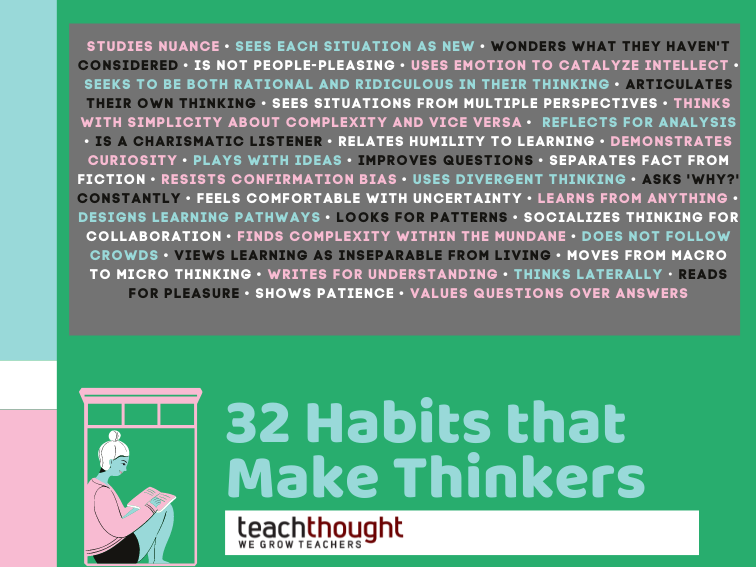
What Are The Habits That Make Thinkers?
by Terry Heick
The difference between students and learners is an important one.
On the surface it’s a matter of tone and compliance, but it also has to do with purpose–why are they learning? How much of themselves are invested in the process? And does it lead to personal change, or mere performance?
So below are 32 habits–or strategies, actions, or behaviors–that can lead to that critical shift that moves students from mere students to learners who are able to think critically for themselves.
Key themes? Patience, scale, and perspective.
32 Habits That Make Thinkers
1. Doesn’t always seek to please others
2. Is a charismatic listener
3. Can learn from anything
4. Asks ‘Why?’ (almost annoyingly)
5. Is comfortable with uncertainty
6. Writes for their own understanding, not performance
7. Values questions over answers (see Why Questions Are More Important Than Answers)
8. Uses widely varying ‘thinking strategies,’ connecting this to that, here to there, then and now, before and after, etc.
9. Uses divergent and/or lateral thinking
10. Can move back and forth from micro to macro thinking
11. Reads for pleasure
12. Looks for patterns
13. Formally and informally see and (formally and informally) studies the nuance of things
14. Sees every situation as something new, because it is something new
15. Asks what they’re missing or haven’t considered
16. Playfully reframes and/or improves questions (see question-based learning)
17. Relates humility to learning, and vice-versa (see also How To Teach For Knowledge Through Humility)
18. Can instantly separate fact from opinion
19. Resists confirmation bias (i.e., they instead analyze then draw conclusions)
20. Thinks independently, willing to be wrong (doesn’t instantly follow crowds, popular ideas, trends, etc.)
21. Articulates their own thinking without prompting (often creatively)
22. Designs learning pathways effortlessly–they just go (see our Self-Directed Learning Model)
23. Socializes thinking for collaboration rather than approval
24. Sees learning as inseparable from doing–and living
25. Reflects for analysis rather than judgment
26. Uses emotion to actuate their intellect
27. Sees situations from multiple perspectives
28. Plays with ideas (without being told–see also Learning Through Play.
29. Can think with simplicity about complexity, and with complexity about simplicity (see the 6 Domains For Cognition: The Heick Learning Taxonomy)
30. Demonstrates an insatiable curiosity for something (may not always be what’s academic or convenient)
31. Seeks to be both rational and ridiculous in their thinking
32. Shows patience (by ‘dwelling with’ questions, texts, or problems)
Bonus
33. Finds the complexity within the mundane
